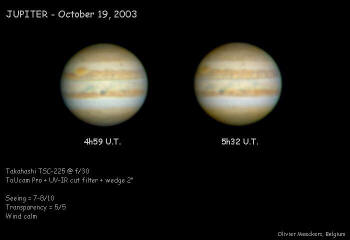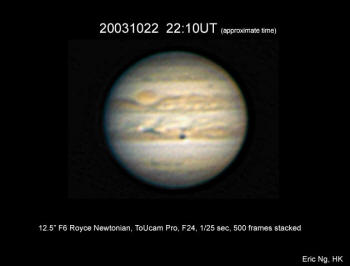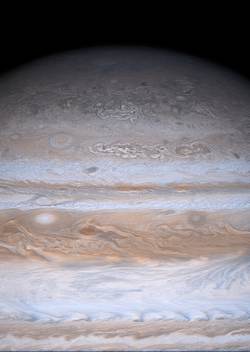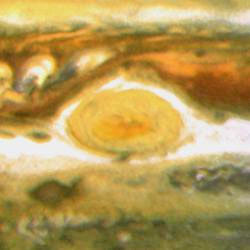|

by Robert Roy Britt
Senior Science Writer
SPACE.com's Night Sky Columnist, Joe
Rao, contributed to this report
23 October 2003
from
Space Website
Astronomers have spotted a strange,
obvious and inexplicable black spot near the equator of Jupiter. A
picture of the object (below image) was circling this planet
electronically this week as researchers scratched their heads about
what they'd found.

A second image (below), taken on another
day by a different photographer, contains a similar looking spot. As
of early Thursday, the second image had deepened the mystery. Some
astronomers were at first puzzled over whether the two photos show
the same thing or not.
As it turns out, they do not.

Researchers said the second image
reveals a transit of one of Jupiter's moons across the face of the
planet. In the end, the two pictures represent an interesting
coincidence.
What follows is a story of raw discovery, a behind-the-scenes look
at what goes on in the Internet Age when astronomers find something
unexpected.
Stormy spot
Jupiter's complex atmosphere is known to generate ephemeral spots,
whirls and cloud formations of various sorts (below image).
Many are colorful; often they are bright, sometimes they are dark.
This one is particularly dark and larger than many seen in the past.

The first picture of the black spot to
circulate among astronomers worldwide was taken Oct. 19 by
astrophotographer Olivier Meeckers. The image gained wider
attention Wednesday as it was mentioned in astronomy newsletters. It
had experts captivated.
Meeckers, a member of Groupe Astronomie de Spa in Belgium, told
SPACE.com he does not know what created the spot.
Jean-Luc Dighaye, who founded a European amateur astronomy group
called the EurAstro Association, discussed the odd spot with
Gino Farroni of the French Astronomical Society and Emmanuel Jehin, a
staff astronomer at the European Southern Observatory.
"The black spot, accompanied by at
least one plume, can be seen not far away from the Great Red
Spot," Dighaye said.

Jupiter's Great Red Spot is a colossal
cloud structure, much like an oversized hurricane, that has been
raging for at least three centuries. The new spot is an obvious
dark
circular object below and to the left of the Great Red Spot in Meeckers' images (he took two at separate times on the same day).
Not a shadow
In an e-mail interview with SPACE.com, Dighaye said the dynamics of
Jupiter's atmosphere, with convection and radiation generating
strong winds and changing cloud structures, is not well understood.
"Spots of various shades depending
on the chemical composition of the gases involved in the process
are observed from time to time," Dighaye said. "Plumes indicate
gas exchanges with the adjacent atmospheric streams which are
always fast in the equatorial zones."
These streams - which generate
Jupiter's characteristic stripes - move at different speeds.
It is not known if the spot is purely an atmospheric phenomenon or
if it might have been generated by some foreign object, though the
latter possibility is doubted. In 1994, impacts of the fragments of
Comet Shoemaker-Levy 9 created huge black scars in the Jovian
atmosphere.
"This time, however, astronomers did
not report the presence of any potential nearby impactor,"
Dighaye said.
Jupiter shines by reflected sunlight.
Shadows from the four largest Jovian moons can also create spots on
the planet's cloudtops. But the astronomers checked the schedules of
the moons' passages and, in three independent investigations, ruled
them out as the cause of the spot in Meeckers' image.
Mystery
deepens
Then a second image emerged, taken by Eric Ng of Hong Kong on Oct.
22. It shows a dark spot on Jupiter in roughly the same location as
the strange spot seen by Meeckers.
Ng told SPACE.com the spot in his photo is the moon Ganymede, which
shows up very dark compared to Jupiter's bright clouds. Dighaye at
first considered the situation very unlikely, as the moon's location
would be coincidentally superimposed on Meeckers' strange spot.
"That's incredible!" Dighaye said of
the possibility.
But there was more information that
apparently hadn't been taken into account.
Other astronomers, drawn into the discussion, agreed the spot in
Ng's image is Ganymede - not the moon's shadow, but actually the
moon itself - perhaps coincidentally positioned over the strange
spot imaged by Meeckers. That account came from an e-mail discussion
among members of the U.S.-based Association of Lunar and Planetary
Observers (ALPO).
However, it soon became clear there was another explanation
altogether.
Because Jupiter's cloud bands move at different rates, Meeckers'
spot had rotated to a new location, and apparently morphed into a
less noticeable shape and shade, by the time Ng took his picture
three days later, according to Geoff Gaherty of the Royal
Astronomical Society of Canada. Gaherty was alerted to the apparent
similarity between the images when he read the initial version of
this story.
Ng, re-interviewed, agreed with Gaherty's explanation.
That still leaves the original strange spot, the one found by Meeckers,
unexplained. Another well seasoned Jupiter observer
weighed in late Thursday, suggesting that dark spots in the Jovian
clouds are not as rare as some astronomers think. Nonetheless,
scientists know little about what causes the spots.
See for
yourself
Meanwhile, observers are working with a narrow window of time each
day to learn more about the unexplained spot. Jupiter rises in the
East at around 3:30 a.m. local time and is high in the sky at
daybreak. But since it rotates, the hemisphere with the new and
perhaps fading spot is not always facing Earth.
"It would be exciting to follow the
evolution of this new black spot -- probably still visible in
modest astronomical instruments -- from many locations of
various longitudes on Earth, so that some observers are always
favorably positioned when the Jovian hemisphere of interest
comes into sight," Dighaye said.
Jupiter is visible to the naked eye. It
appears as a very bright star in the predawn eastern sky. In fact it
is brighter than all stars and cannot be mistaken.
Binoculars or small telescopes can reveal up to four points of light
near the giant planet. These are the Galilean moons. A modest
telescope -- about 4-inches -- will reveal the major cloud bands of
Jupiter.
In general, larger amateur telescopes
are needed to show smaller features like the newfound, unexplained
black spot.
|




